Many argue there‘s no need for trucks in the 700 and beyond horsepower bracket. But what if your transport mission is keeping the minute-critical heart of a primary sector giant beating with zero tolerance for compliance infringement? Maybe then the arguments for big horses start to ‘Talley‘ up.

Without the input of a good conductor, all violins, trumpets, horns, timpani drums, oboes, saxophones, and tubas do is make noise. With a top-notch baton-waver however, you get a symphony instead. Trucking‘s most valuable jewel is also its most maligned and feared position. Like the head rig operator in a sawmill, the dispatch or operations office in a transport business is where all the variables meet, and where trucking‘s symphony is conducted from. It‘s the place where deck space meets loads, meets driver skill and availability, meets customer expectation. You can employ as many walking overheads as you like with the fanciest of titles you can think up, but if operations is running with the left shoe on the right foot, you‘ll go broke. You would think overseeing an internal transport operation cell where you only deal with your own people and product would be a doddle compared with the trauma of pleasing Joe Bloggs and Jane Doe in the outside world. You‘d be wrong. “If a fishing boat is 24 hours from Bluff then we have to get there to empty it,” says Hayden Reed, freight operations manager for Talley‘s Limited. “If there are multiple loads of peas to be trucked ex Ashburton at the same time, and containers in Motueka, then that needs to happen too.” It‘s both exciting and daunting listening to Hayden and southern freight manager Brad Guilford chat about their orchestra and the logistics symphony they conduct in order to keep one of the country‘s most respected food brands on point.

Photo: The big Scania heads into the rolling country of lower North Canterbury.
Playing by the rules
We‘ve been here before: a company whose core business is not transport, deploying trucks to ensure their day-to-day goals, dreams, and aspirations can‘t be ankle-tapped by failed pick-up or delivery promises. But Talley‘s takes things a step further inside their transport cell. Their goal is one hundred percent compliance. No questions, no discussion, no exceptions. “There are stringent food product and health and safety rules and expectations right throughout our business, and the truck cabs are part of our workplace. If that‘s the rules, that‘s the rules. We play by the rules,” says Brad. If we‘re being brutally honest, high service expectation and on point compliance are not historically a perfect union in the world of road transport for reasons only the industry itself can answer. There‘s no argument that one benefit an internal supply and distribution chain has is the ability to operate in a scoundrelfree world with no one sneaking in the back door decimating your realistic rate, dangling the cheap yet impossible alternative. But make no mistake, this is a high-pressure operation. The customer is demanding. The fleet doesn‘t just deal with the fruits of the company‘s labour, it also delivers what‘s required to make it all happen. “People think if you open a Talley‘s truck it‘ll be full of veges, ice cream, or seafood,” said Brad. “But it might also look like a line haul freight truck. It might have pallets of packaging, factory equipment, gloves, groceries, washing machines, you name it!” “Washing machines?” “Yep.

Photo: Brad Guilford, southern freight manager for Talley‘s Ltd (left), and freight operations manager, Hayden Reed. The S730 fell within budget and provided the opportunity to make the driver‘s day easier and safer, so they took it.
A vessel might be coming into Dunedin and one of the ship‘s washing machines has failed. They tell the company provedores in Nelson, and we simply have to get it there. Then there‘s trawler re-wires, 11-tonne spools of wire that tow the nets. We wind the new wire onto the boat‘s drums, and the old off the boat directly onto the truck. The list is endless.” Yet for all this, the Talley‘s freight cell in Christchurch is not full of people with nervous twitches wringing their hands, or scratching their arms until the skin is raw. It‘s a calm and cheerful place, and driving cadet Jayden welcomed us as he took our forehead temperature to make sure we weren‘t bringing you-knowwhat with us. In trucking, the way it often happens, it‘s the ‘noise‘ that makes life hard, meaning all the stuff that gets in the way: things like overloads, speeding tickets, and minor logbook infringements. That all goes away here, and it helps create a known set of boundaries for what can and can‘t be achieved. “If you can keep two days ahead, that really is the key,” said Brad. “Big surprises tend not to work. We‘re lucky we have a good team across the wider company management, and constant communication is key. If something looks like it‘s not going to play out, we just keep talking until we have a solution. Yes, we do have a pool of trusted subbies we can call on if we have to, and the expectation here is they‘ll play by our rules.” But playing by the rules doesn‘t mean you can‘t extract the maximum from the terms of engagement. Aligned to that exact premise and parked just outside the office at the company‘s Ivan Jamieson Place yard in Christchurch was the reason for our visit, a gleaming new S730 Scania 9-axle rigid and dog reefer unit. Now that‘s a lot of truck!
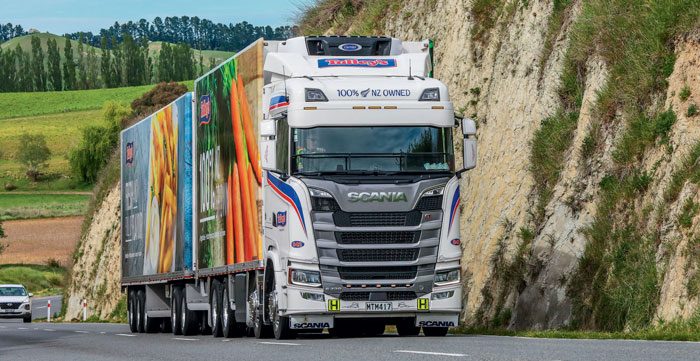
Photo: Thundering up a box cut north of Cheviot.
‘Position, possession, and pace‘
The words of Fred ‘the needle‘ Allen, one of the great conductors of All Black on-field symphonies, but very apt when confronted with such a machine. Vetting the article, Talley‘s management might have squirmed momentarily at the word ‘pace‘, but let‘s be honest here, they‘re a onehundred percent compliant firm, and you don‘t buy 730 ‘horses‘ if you‘re not wanting to get 30 tonnes of time and temperature-sensitive product where it needs to be, when you want it to be there. If the speed limit up a big lazy climb is 90kph and you have truck that‘ll climb it at 89.9kph rather than 54.8kph, that‘s just fine, and nothing to be embarrassed about in any way. Possession, well, you need to entrust all those horses with someone trustworthy. Ideally a bloke who‘s well known to the company, the sort of guy who could put a million kilometres on a highend truck without mishap. Finally, there‘s position. Te Waipounamu is a beautiful place when it comes to extracting the most from ‘big-jiggers‘. A long, thin land mass split down the guts by huge mountains, a highway system down each side, with a few big crossings. Many of the climbs you can either hoe into with a bit of pace on, or they‘re just generally longer than their North Island counterparts.
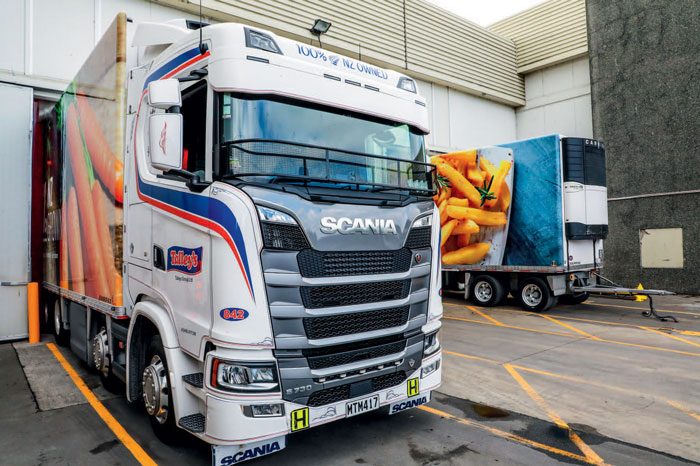
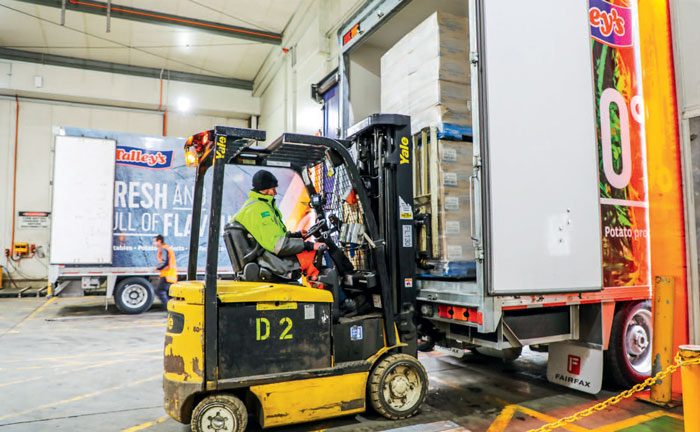
Photos: Loading in Ashburton.
To use a slightly crass trucking vernacular from over the ditch, ‘you need to be able to get up it mate‘. Although there are a small handful of set runs, Talley‘s trucks can in all reality be found anywhere in either island; the dominant task for the new Scania – eventually – will be a daily Ashburton to Blenheim and return. It‘s a 780km rounder, not currently achievable on account of the ongoing remedial work on the Kaikoura coast as well as a bit of infrastructural farting around in Christchurch. The Scania is a truck bought with the future in mind, no question. “We haven‘t been able to do Ashburton–Blenheim rounders consistently since the earthquake [2016],” said Hayden. “Ironically, sometimes over Christmas it‘s possible because the roadworks are fewer. Prior to the quake it was doable with an hour or more to spare, but now it‘s four runs in five days with accommodation, rather than five in five days and the driver getting home every night. It‘s cost a fortune in accommodation and overnighters. Hopefully that‘ll change in the not too distant future.” Wandering outside with Hayden and Brad we‘re struck by the enormity of the S Series cab. It‘s a big ole shed, standing significantly higher than the R Series we sampled in June this year.
What the S‘s higher lines instantly do is deal to the at times confronting look imposed by the NTG cab‘s expanse of glass. The S Series proportions are beautiful, and everything falls easily on the eye. We asked Hayden about the choice of the S730, and Scania generally. “The easy solution would have been an in-stock Argosy, backed under the old truck‘s body. It would have been off, on, and we‘re trucking within a month. But that would also have flown in the face of our desire to improve the safety of our drivers‘ workplace. We priced an R620 and the response was more favourable than we‘d been expecting, so we asked about an S730. The number was still acceptable, and so we went that way instead. In the end it‘s a big run and we want to use every tool available in the toolbox to make the job as safe, comfortable, and achievable for the drivers as we can. “In terms of Scania, there‘s the safety as mentioned, but there‘s also fleet consistency. “Here in the Talley‘s line haul business, it‘s largely a one driver, one truck operation, but in our Open Country Dairy business for instance, it‘s more dynamic. The cabs are all the same and moving from truck to truck is simple. If we had to take a truck out of this operation and put it in one of the others, it wouldn‘t be unfamiliar to the drivers. In some of the other makes we have, identical units built close together have switches in different places.
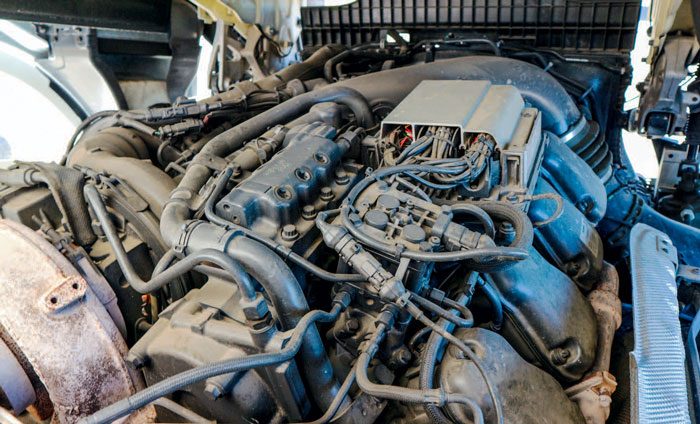
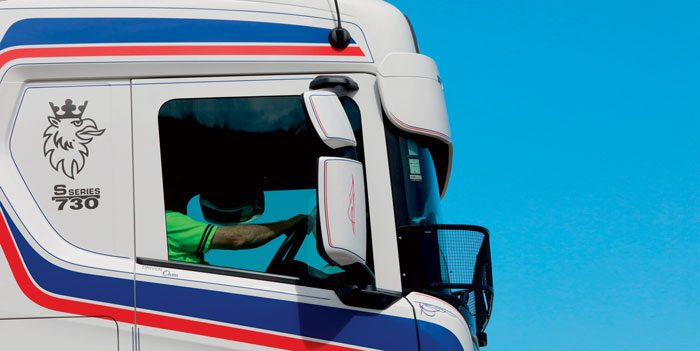
Photos: It‘s a big lump of grunt. The DC16 in 730 trim.
We don‘t get that with the Scanias. Having said that, every purchase involves a rigorous process of vetting the application, price, and lead time. We‘re in no way blind to any other brand by any means. It‘s not a done deal before it starts, ever. “We also like the Scania setup here in New Zealand now. You‘re not dealing with an agent, it‘s Scania, the people who built it, and the culture they‘ve set up we think is fantastic. They‘ve been great to deal with. Even though we don‘t do ScanPlan, we‘ve had no issues in terms of service.” At that moment the S730‘s driver, Owen Thornley, walks around the corner. A 12-year Talley‘s veteran, he‘s just come off his beloved DD15 powered Freightliner Argosy, having done all of its millionplus kilometres – go figure – that‘s just the sort of driver we said would be ideal! The big Scandinavian has taken Owen a bit of getting used to. That‘s not really surprising, given it‘s a bit of a Xena Warrior Princess versus Mary Poppins approach to things, meaning one‘s an all-in hack your head off approach to the job, whereas the other‘s a bit more brolly and sugar – albeit with a 16-litre V8 brolly and a shit-load of sugar!
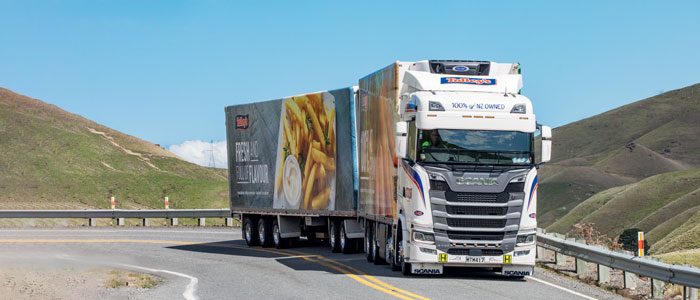
Photo: Descending Weld‘s Pass.
Walking on sunshine
A more glorious day for a run north from the garden city you could not have hoped for. The journey up to Blenheim is a game of two halves: flat at the start, steadily climbing the further into North Canterbury you go, with the first half culminating in the climb up and over the Hundalees. From there you drop down onto the Kaikoura coast, before the leg inland and over the hills behind Clifford Bay, finally winding your way down the Welds Pass, and popping out in Blenheim. We ascended the 5-step entry into the leatherette-clad seats and opulence of the S Series cab, and looking out through the windscreen at the people below, we were expecting to see a sign saying ‘If an oxygen mask drops down in front …‘ Owen kicked ‘big rumbly‘ in the guts, gave the Scania park brake valve the signature pull-and-flick, turned the Opticruise controller to D, pressured the throttle with a deftness of touch, and just like that, Christchurch was a memory in the mirrors. The ease with which this machine got its permitted 53,860kg rolling was absurd. The uninitiated looking on from cars alongside the truck as it passed through the intersections in and around Memorial Arch could have been forgiven for thinking it was an empty. But nothing could have been further from the truth. We had just under 29 tonne of frozen fries on board. Owen carts a variety of produce on this run, depending on the season obviously.
Interestingly, Brad told us peas were one where loading has to be watched carefully as they can be heavy little buggers. Who knew? Holding a pea in your hand hardly conjures up the thought of a 9-axle reefer being in weight trouble. Out on the Northern Motorway there was no chance of straining vocal chords chatting at 63dB in cab, and even rolling onto the chipseal, noise only crept to 65. Owen is based in Ashburton and that‘s where he‘d set out from that morning. He was aiming to get to Blenheim, unload and reload, and then hopefully make it back to Kaikoura. “If the road works aren‘t too busy, we might make Blenheim for our break, otherwise it‘ll be Ward or Seddon or something,” he said. What he‘s referring to is driving in the world of the electronic logbook. “No, it‘s all good,” Owen says with a chuckle. “Seriously. The world changes and that‘s just how it is. Yep, you might think what a funny place to stop, I‘m only 10 mins away and the storeman could unload while I have a cuppa, but that‘s the old way, and this the new. When they put them in, they were going to leave me until last – old dog, new tricks I guess, and I tend to say what I think, but I said, ‘no, put mine in first‘. When they asked why, I said ‘if this is how it is, that‘s fine, and seeing me embrace them might help the cultural change.
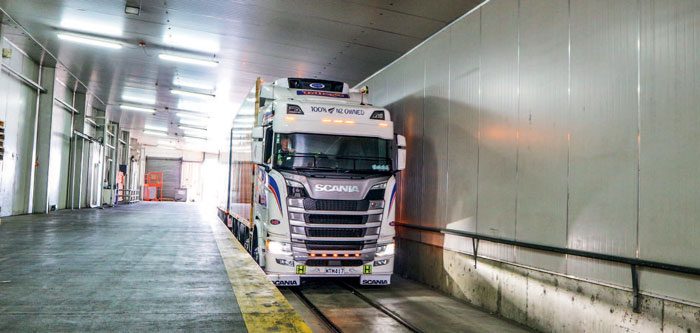
Photo: Owen rolls into Blenheim.
It was the same with the cameras [Seeing Machines]. Putting them in the older drivers‘ trucks first smooths the transition‘.” Owen‘s approach is beyond commendable for a man with his years in trucking; ours is a little less accepting … if we might have an editorial moment mid-test. We fully support good, well-thought-out compliance, no question, but New Zealand‘s driving hours laws have nothing to do with anything relating to fatigue. Absurdly, their roots lay in post-depression rail protection. In 2020, a law mandating when a person will and won‘t be tired is ridiculous. When we did eventually bring the Scania to a halt 20 minutes from Blenheim, Owen had been laughing and chatting about his life, his kids, the truck, the scenery, all at a climate controlled 20-odd degrees. In no way did he appear on the brink of a fatigue-induced collapse. Twenty minutes up the road he could have taken 45 minutes, even an hour, to eat his sandwich and have a cup of tea while the truck was being unloaded. But no, it sat 20 minutes from Blenheim, a supreme multimillion dollar example of bureaucratic paralysis stymying productivity.

Photo: Mike Anstis unloads Owen at the Talley‘s Blenheim cold store.
Electronic logbooks and strict adherence to compliance? No issues, in fact eventually it may affect freight rates positively. The law such devices administer as it currently stands? Absolute bollocks, and the industry‘s big players and representation have to start bashing the table on this. The first minor delay occurred at Glasnevin when the S730 was summoned in for a once-over. ‘Nothing to see here people, move along‘. Pushing north into the Greta Valley and beyond, the country begins to dip and rise, dropping into river catchments and climbing over foothills, as mountains, sea, and road all start to vie for the same spot. It‘s pure entertainment listening for the tonal change emanating from the 8-pot monster deep beneath the floorboards, the faint thump thump separating out, and then coming back together as the Scania crests the undulations. “It‘s such a different truck from the Argosy,” says Owen. “I‘m fine with it now, and every day I‘m enjoying it more and more, and at 67,000 it‘s starting to really go.”
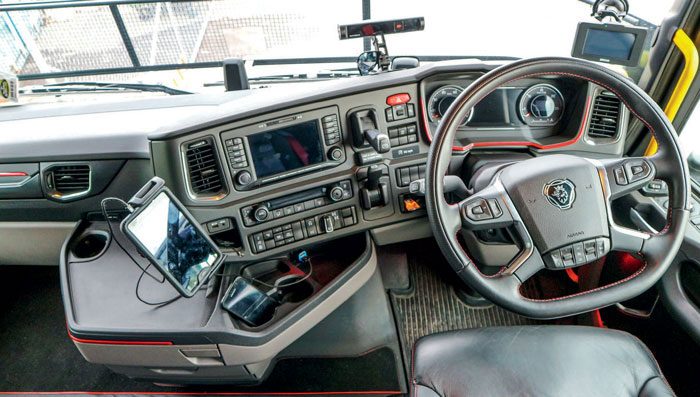
Photo: Still one of our favourite Euros.
Over the gain line
There‘s no arguing the DC16 in 730hp trim is a brute of an engine, outputting a whopping 545kW (730hp) at 1900rpm and 3500Nm (2581lb/ft) from 1000 to 1400rpm. At 54 tonne those peaks represent 10.1kW/tonne (13.5hp) and 64.8Nm/tonne (47.80lb/ft). It‘s little wonder things happen when the go pedal gets squeezed. The 16.4-litre V8 thumper has Scania‘s XPI (Extra High Pressure Injection) common rail fuelling system, four valves per cylinder, and sports Euro 6 emissions via EGR and SCR. Behind it is the company‘s 14-speed GRS0925R Opticruise AMT with retarder. At the front, twin Scania AM640S axles at 7100kg each sit fully air suspended, while out back a Scania AD400SAP hub reduction bogie with diff lock and rated at 19,000kg, resides on dual spring and 4-bag suspension. “The front air suspension was a no-brainer,” says Brad. “It means we can get accurate and optimal load weights regardless of where that loading is happening, and the hub reduction diffs are more or less the same tare so longevity was the key driver behind them.” EBS/ABS disc brakes furnish the entire unit, as do Alcoa Dura-Bright alloy rims, and it rolls on 275/70 R22.5 rubber. Of the big Euros we‘ve sampled lately, namely the Northchill DAF and Iveco X-Way, the Scania‘s 4-bag air suspended cab seemed the least reactive to the road surface.
That‘s possibly attributable to the South Island‘s generally better roads, although having said that, the appalling surface of SH1 north of Kekerengu to the Lion‘s Back south of Blenheim failed to get it overly agitated either. Coming from an Argosy, it‘s certainly a lot softer than Owen‘s been used to for the thick end of a decade, so we‘ll avoid using ‘firmer‘ when drawing comparisons with the other recent Euros. Into the Greta Canyon and the S730 bowled on over in 10th, dipping to 1100rpm and a hair over 50kph. Dropping off one of the crests and down steeply, the exhaust brake and 4100D retarder combo lit up the show with its customary and reassuring whine that makes it sound more like a locomotive than a truck. The retarder is active on all five stages, with an exhaust brake to add additional braking. The peak pull-up potential is 4100Nm (3024lb/ft). “You pretty much don‘t have to do anything in this,” says Owen. “Just set the speed and it all just happens.” Speaking of which, the AMT? “No, I just leave it in ‘A‘ pretty much all the time. It handles it all easy, it‘s got that much power. It‘ll drop back to around 1000 to 1100rpm and just pulls away.” Yes, it has got ‘that much power‘ indeed, and big power in engines of this era should be there to carry speed so torque has a better base on which to start doing its thing. The 730 rolls into hills, and from the moment the front wheels hit a gradient, it‘s gravity that has to really work hard in order to wash off speed. In say a 13-litre motor of 400-odd kilowatt at these weights, it‘s the opposite.
The power struggles to hold the ground speed into the climb, and by the time torque‘s moment in the sun looms, momentum‘s dropping so quick it‘s like trying to catch an Olympic shot put dropped from an airliner. Suffice to say, you might be strong as hell, but it‘s going to smash your hands and squash your toes. As a result, the truck bogs down until the transmission can grab a low enough gear, and then the claw-back commences. It‘s why drivers in New Zealand‘s hilly terrain still like to intervene and manually find the gear that will keep revs up and stem the rate of speed loss, and it‘s why OEMs have ‘Hilly Terrain‘ AMT program maps, essentially doing the same thing. With this beast, however, big power takes the edge off the rate of speed loss. To use the analogy above, it‘s more like us catching a medicine ball chucked off a balcony. The AMT has ample time to react to the rate of speed being lost, and the handoff between power and torque is not the hospital pass it is in smaller engines. Add to the recipe the enormous torque the big engine‘s producing, and it‘s a win all round for the truck in the war of physics and maintenance of progress. To put it all into perspective, in terms of the DC16 730, at the point the two lines cross on the way down the revs, the motor is churning out just north of 500kW (670hp).
Even at 950rpm it‘s producing 351kW (470hp). In Owen‘s office, what that feels like is momentum, and in trucking, momentum is good! In Hayden and Brad‘s office, it feels like productivity, and in management‘s world, productivity is also good! Rolling into the base of the Hundalees the Scania again bores into things and holds 11th gear at 1100rpm and 55kph before Owen has to adjust for cornering requirements. The further you get into these hills, the more tight and windy they get, and that‘s when productivity becomes the realm of the driver. Remember in June, Pin and Bomb Te Huia shied away from a 730 Scania because the Coromandel is just too twisty and tight to get that extra benefit. Like the Coromandel, the northern section of the Hundalees is a bit narrow and tight, and so Owen just lets the truck find its way up without leaving vast swathes of steer and drive rubber on the ground in his wake. That‘s experience and maturity right there, just what‘s needed to extract the most, from a lot.
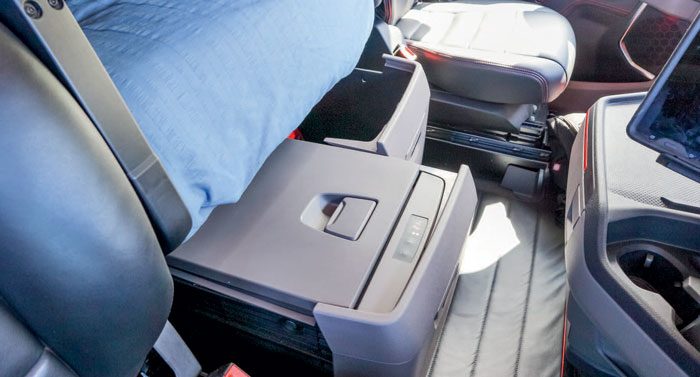
Photo: Almost a modern-day essential.
Seeing is believing
And believe us when we say you can see and awful lot from up here. Five steps up, with ample grab handles … in bright yellow. You might think, like we did initially, why you would want someone driving your S730 up the track who needed bright yellow paint on the grab handles in order to see them? Like everything there‘s a plausible, and can we say reassuring, reason. “Health and safety consistency across the fleet is the driver here,” says Brad. “Also the yellow grab handles have a slip-free coating as opposed to the smooth, shiny finish on the standard black handles.” The Scania NTG interior is a familiar hotel to us now; the obvious thing in the S is the entirely flat floor. It‘s not as safe as houses, it‘s safer! Whose house complies with ECE- 29 and has the airbags this thing does? Fit, finish, trim, and materials are barsetting – durable, and high quality, to use our old Scania, Volvo, Mercedes-Benz chestnut: serviceable luxury. Oh, and yes, there‘s colour, with some snazzy red flashes amongst the fawn and black. Well done you people in the Griffin‘s nest! The driving position is superb; millimetres are everything in ergonomics and a few tweaks in the NTG brought the driver closer to windscreen and door, making fabulous, superb. Visibility to the front is fantastic, with left and right clearance as good as you‘d get in a mirrored cabover.
While we‘re talking mirrors, they‘re great, but Traton‘s answer to mirrorless must be looming you‘d think. Eyes on the dash, there‘s a two-gauge binnacle with fuel and DEF as bar gauges lower down on the dials, and a central truck, trip, and driver diagnostics screen between them. The big wrap is a lot more integrated than others in the genre, with all the usual climate, brake levers, switches, traction controls, and infotainment. Left column wand is wipers, indicators, and dip, and the right transmission, retarder, and brake blending controls. The smart wheel left spoke sorts out the ‘sounds‘ and the phone; right is vehicle data, and the tumblers lower down are adaptive cruise and descending. The air suspension controls are down on the bottom right of the dash and on a remote on the floor by the driver‘s seat. Of course there‘s the driver‘s door sill which in itself looks like it has more buttons and switches than Houston Control at the time of the moon landings, even housing the headlight controller. The Talley‘s machine has the Normal CS20N cab rather than the Highline version, although ‘normal‘ in Scania‘s world is not the same as many others‘.
Obviously the flat floor in the S Series helps afford a clear 1960mm headroom, ample for most to stand up in, but that aside, you still get substantial front and overhead locker space and a higher than … well, ‘normal‘ roof line. The lovely big central console has oodles of storage and flat bits for clutter, with more storage lockers up behind the bunk, in the side pelmet, on the right-hand sleeper wall, under the passenger seat, as well as the must-have fridge, and pullout stow bin under the bunk. Owen also has a TV for R&R. Externally there‘s a quad locker setup. Even in this ‘normal‘ guise it‘s a motorhome, people. Daily checks are all under the front, and yes there‘s still a dip-stick. What we love? As we‘ve said before, the uber mod Scania interior still feels like a truckies‘ truck. Gripes? Geez, there‘s a lot of switches on that driver‘s door sill. One bash and you‘re potentially cast, especially with headlight controls there.
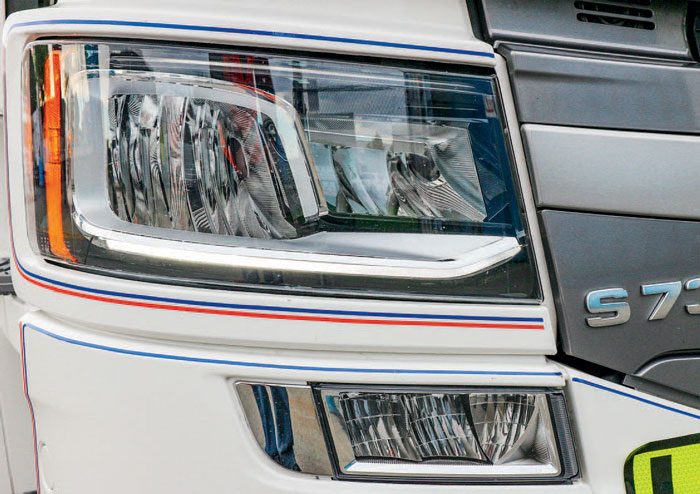
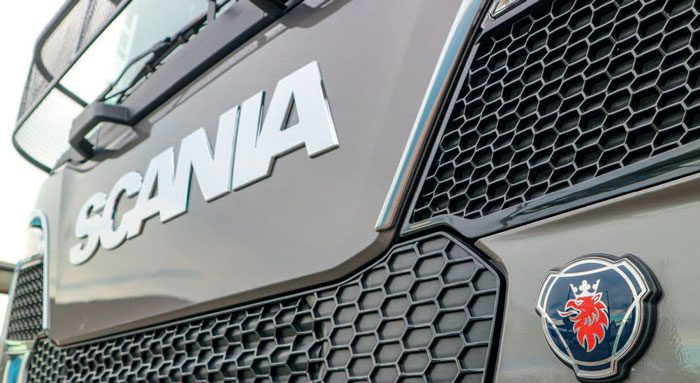

Two for one
Steering and braking in the big Scanias is, as we know, superb, and as you‘d expect in a pinnacle Euro it‘s dripping with safety tech. Adaptive Cruise, Advanced Emergency Brake, Eco-roll, and Hillhold, they‘re all there. Lane Departure is available as an option. Rolling on up the Kaikoura coast big ‘Griff‘ certainly helps calm any stress and tension the endless roadworks would have induced in a lesser machine. Its ability to roll along in the flow of traffic, holding its place easily from standing starts, and the Opticruise‘s almost undetectable razorsharp shifts, meant life in the cab was all about the state of the ocean and affairs of the world in general. Imagine an old R Model Mack at 48 tonne (c‘mon, we know how it was), trying to get up the coast with 10 or more stop/go sites. If you weren‘t of the era and can‘t imagine what it was like, let us help … sweaty, tired, hot, noisy, and angry. The swing inland at the Waima Ure River brings an end to the seaside amble, and has the big Swede again on song. Constantly servicing multiple locations from all directions, the teams at Talley‘s transport cells keep empty running to as little as humanly possible. On the Blenheim run Owen is nearly always loaded the whole time. Taking load factor into consideration as well as gross weight, even the tare at around 25 tonne, and of course the big bopper up front between the rails, you might be forgiven for thinking fuel use could be the minus you pay for all the pluses. Well, maybe not. All variables considered, this T-Rex appears to be signed up at Weight Watchers, running a life to date average of 1.84kpl. Again Euro 6 appears to raise the bar on fuel consumption expectation in whichever category it pops up in.
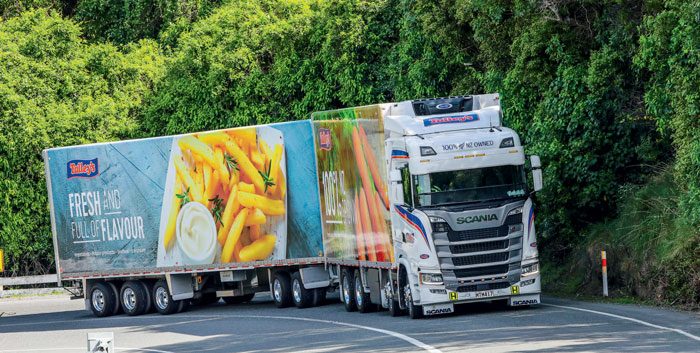
Photo: Big power needs to be finessed in the tight stuff.
For us, that‘s a better than honest figure for this machine. As hinted at previously, for all our good intentions and attempts, we ran out of clock at Seddon of all places, so it‘s there we stopped for a cuppa. The first thought in the mind of any truck buff seeing the Talley‘s Group S730 Scania 9-axle rigid and dog combination for the first time is probably cost. There‘s the ‘S‘ on the front grille, a 730 badge next to that, sleeper cab, an 8×4 configuration, and refrigerated bodies. It‘s as close to the top of the tree in terms of capital spent on a truck and trailer as makes no odds, and even if you had seven figures saved up, don‘t expect a lot of change. Although you could buy a fleet of them for the worth of one deep-sea factory ship, it‘s still a huge outlay in trucking parlance, and transport operations at Talley‘s must contribute, not just cost. While the Scania got a new body, the trailer‘s the one off the Argosy, but she‘s had a good old tidy up. Basic spec on the bodies is 30mm foam composite floor with aluminium planks and fork hoist rated. One feature of the new composite floors is no screws, so leakage with age, racking, and wear, is hopefully eliminated. “After a million kilometres the trailer floor was a bit tired and leaked when carting fresh fish or mussels,” said Brad. “We re-floored it to match the truck‘s technology. Both units have two shoring bar rails, and temperature dividers.
“The body on the truck is on a subframe built to be almost flush with the rails. It ended up being higher than it was meant to be, so there was a bit of work to be done there. We absolutely have to get through the Lyttelton Tunnel at 4.27m, and we‘ve ended up at 4.255, five millimetres higher than we aimed for, but it‘s a pass nonetheless. “The trailer runs on BPW disc brake axles and suspension and aside from the floor it‘s had a new door frame, guards, Dura-Bright rims, the works. “We run Carrier fridges. They‘re a great product and Transcold‘s backup service is great. If it‘s hiccupping and we call, they come; it‘s fixed. When the load‘s worth as much or more than the truck, the fridges must go. We also use Euroscan so we can see what‘s going on. “In terms of life, we‘ll start the replacement process when the truck‘s done about 900,000km. We need director‘s approval, then ordering, lead time, and build slots, so by the time the new one turns up, the existing truck should be about the one to 1.1 million kilometres. Just right. That‘s basically how we work it. Moving them on before reliability issues start to appear is important.”
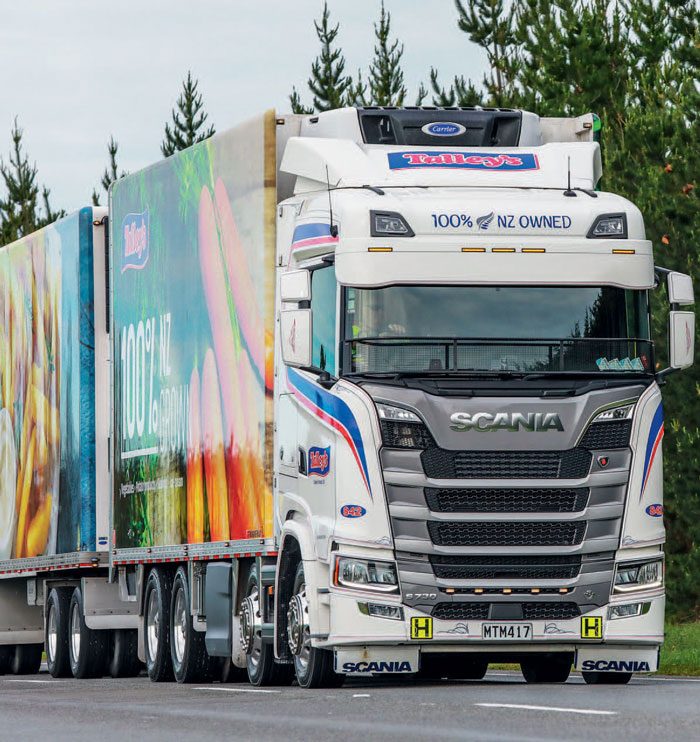
Summary
The break over, we were off. The Lion‘s Back just north of Grassmere was the last big obstacle, but the 730 romped up the gnarliest bit in 8th at 1550rpm and saw 40kph for a just a mo. And before you knew it, there we were, at the foot of Weld‘s Pass in wine country. We unloaded the full load of fries at the company‘s cool stores in Riverlands before Owen headed to another Talley‘s factory in Renwick for his reload. There seemed to be no end to the pallets coming out one by one, yet for the past five and bit hours they‘d made little impression on this machine‘s ability to make a mile. Owen looked nothing like our fictitious R Model driver would have after such a run on a hot spring day. Owen looked like he‘d just turned up to work from a week off. At the end of the day, that‘s what work should be like, especially a job driving class 5 licence combinations. Directing a 23m long, 2.55m wide, 54 tonne machine up a windy carriageway barely wider than itself at up to 90-odd kph for 380km is no mean feat, and anyone doing it should look like Owen did at the end of this run. Is there really a need for trucks in the 700 and above





